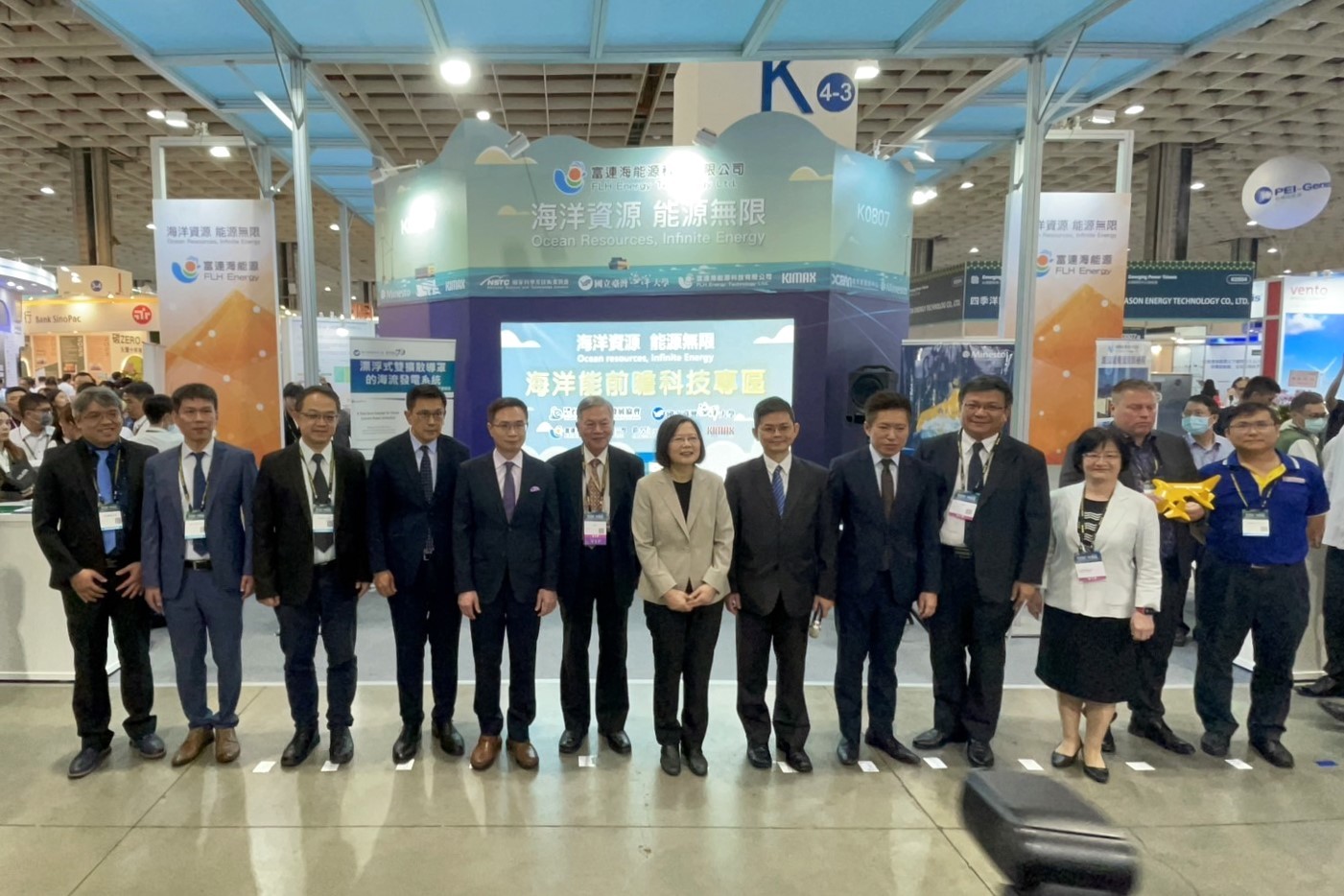Energy Taiwan 2023: NTOU Showcases Industry Collaborative Achievements, Providing Professional Solutions for Energy Independence

From October 18th to 20th, the National Taiwan Ocean University (NTOU) made a significant impact at Energy Taiwan 2023, held at the Nangang Exhibition Center in Taipei. NTOU, in collaboration with esteemed industry leaders including FLH Energy Technology Ltd., Minesto Taiwan Ltd., Kimax Technology Ltd., Lian Tat Company, and the Taiwan Ocean Energy Development Association, displayed pioneering innovations in renewable energy. Their theme, "Ocean Resources, Endless Energy(海洋資源、能源無限)," aimed to provide expert solutions for Taiwan's energy independence. Notably, President Tsai Ing-wen(蔡英文) toured NTOU's exhibit to gain insights into recent advancements in ocean energy technology.

NTOU is actively aligned with national energy development policies, dedicating itself to research in renewable energy while continuously enhancing domestic marine energy technologies and cultivating the talent required for industry growth. Through their close partnership with the Taiwan Ocean Energy Development Association, founded in August last year, NTOU seeks to expedite marine energy development in Taiwan, facilitate energy transformation, and achieve the 2050 net-zero transformation target. Mr. Miin-chieh Chuang(莊閔傑), Chairman of the Taiwan Ocean Energy Development Association, noted in an interview during the exhibition that this joint showcase features cutting-edge domestic and international marine energy technologies and business transformation solutions. Furthermore, it unveiled the world's first technical diagram of ocean energy generation systems, marking the initial construction of Taiwan's marine energy industry landscape. Wave energy and tidal current energy are poised to become Taiwan's primary marine energy sources.

NTOU collaborates with the Taiwan Ocean Energy Development Association to showcase advanced marine energy technologies.
FLH Energy Technology Ltd., a frontrunner in domestic wave energy generation, showcased a versatile multi-axis wave energy converter, which effectively harnesses multidirectional wave energy. Lian Tat Company introduced its unique wave energy generation technology, featuring characteristics such as typhoon resistance, erosion protection, structural adaptability, environmental friendliness, and ease of maintenance. Kimax Technology displayed an innovative bidirectional tidal stream generator, providing efficient energy capture for medium to large-scale facilities, including isolated islands and offshore platforms. Minesto Taiwan also presented their latest technological advancements and equipment.
NTOU's faculty members unveiled several significant exhibits. The Center of Excellence for Ocean Engineering presented key technologies and applications in offshore wind power and marine energy. Utilizing domestically-produced 5G O-RAN equipment, they constructed a 5G private network environment and installed sensors, which, combined with NTOU's onshore wind turbines and marine energy testing grounds, gathered data for various atmospheric conditions, such as sea surface winds, wave patterns, and ocean currents. Additionally, they employed accelerometers to detect vibration data from offshore wind power equipment. These installations confirmed the practicality of oceanic 5G O-RAN applications across four different field scenarios: onshore wind power stations, offshore workboats, onshore and offshore substations. This progress is expected to extend to multiple applications, including establishing internal networks for cruise ships and facilitating wireless transmission for containers and refrigerated containers in maritime shipping.
Professor Chau-chang Chou(周昭昌) from the Department of Mechanical and Mechatronic Engineering introduced a solution to address the intermittency of renewable energy generation. NTOU, in collaboration with the Metal Technology Research and Development Centre and the National Atomic Research Institute, has developed a wireless data acquisition and monitoring system for combining wind and solar energy with different battery storage systems. They have already established the first wind power generation site incorporating liquid flow battery technology in Northeast Taiwan. This initiative aims to help stakeholders in offshore wind power grasp evolving trends and opportunities.
 |
 |
(Left) NTOU collaborates with the MTRDC and the NARI for industry-academic research and development of wind energy storage technologies.
(Right) Prof. Young-zehr Kehr's "Wave Blocking Ship" technology effectively extends the construction period for offshore wind energy projects.
Professor Young-zehr Kehr(柯永澤) from the Department of Systems Engineering and Naval Architecture, who recently received the Bronze Award at the Taiwan Innotech Expo, presented a "wave-blocking ship(擋浪船)" technology, which promises to extend construction days for offshore wind power projects effectively. Additionally, Associate Professor Bor-jiunn Wen(溫博浚) from the Department of Mechanical and Mechatronic Engineering showcased a practical training program for image sensing and analysis using unmanned aerial vehicles. This program aims to train professionals for tasks like wind power inspection and disaster surveillance, with diverse applications across various industries. Moreover, Professor Hung-bin Lee(李弘彬) from the Department of Optoelectronics and Materials Technology presented a simulation and validation test of an anti-corrosion system for underwater structures of offshore wind turbines. This system protects the underwater foundation of offshore wind turbines, preventing various marine corrosion phenomena. Professor Shiaw-yih Tzang(臧效義) from the Department of Harbor & River Engineering contributed with his wave characteristics analysis of maritime areas. This research provides the probability of wave cycle conditions occurring in maritime areas and the cumulative wave energy in different wave cycle conditions, serving as preliminary design references for wave energy converters (WECs). Finally, Professor Chen-chou Lin(林鎮洲) from the Department of Mechanical and Mechatronic Engineering introduced an optimized geometric design for an L-shaped oscillating water column-type wave energy converter, aiming to enhance energy capture efficiency and reduce the cost of wave energy generation.